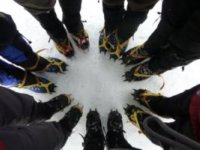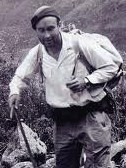Can anyone tell me if they use Ginkgo and find it to be effective? I'm especially interested in what Dr. Hackett says about cold hands:
"...Ginkgo really helps peripheral blood flow in the cold, and at high altitude."
Study results:
http://www.everestnews.com/stories024/peterh.htm
Ginkgo Biloba
-
RichardK

- Posts: 727
- Joined: Sun Sep 30, 2007 12:33 pm
We took ginkgo starting a week before each of our 5 Whitney summits. It definitely seemed to help prevent altitude sickness. We never felt nausea or dizziness. We did other stuff as well: arrive early and spend time at altitude, drink a lot of water thirsty or not, eat periodically hungry or not, take a handful of aspirin at the start. I didn't notice much effect on cold hands, but my hands turn to ice if the temp is below 70.
-
norma r

- Posts: 707
- Joined: Thu Nov 06, 2008 4:22 pm
since Ginkgo increases blood flow i wouldn't be surprised that it could help in keeping extemities warmer in cold temps or at altitude. i do know that because of the increased risk of bleeding, if you are going to have elective surgery you will be advised to discontinue Ginkgo one week prior to surgery.
-
obie

- Posts: 339
- Joined: Thu Jan 07, 2010 9:36 pm
I would be looking for increased blood flow to hands. Have problems on MTB with long descents in cold/altitude - numbness, cold in fingers. I remember road cyclists (pro climbers in particular) getting busted for using Viagra a few years back. Ginkgo a lot cheaper than V. - bought btl. of 100 @ 120 mg. for 18.00. Thanks for input.
-
RichardK

- Posts: 727
- Joined: Sun Sep 30, 2007 12:33 pm
There is a treatment where the body can be trained to keep the hands warm when the weather is cold. It is used to treat a disease known as Raynaud's syndrome, but it might well work for anybody. The logistics are a little messy or I would have tried it myself.
There is a story here:
http://www.nytimes.com/1988/01/19/scien ... hands.html
http://library.mothernature.com/l/the-d ... _2683.html
There is a story here:
http://www.nytimes.com/1988/01/19/scien ... hands.html
Here is another reference:Three to six times a day, every other day, Raynaud's sufferers undergo a treatment in which they first sit indoors with their hands submerged in warm water and then are put in a cold environment, exposed to the cold except for their hands, which are submerged in an ice chest filled with warm water.
After 50 rounds of treatment, all of the 150 test subjects at the laboratories here were able to venture into the cold without losing circulation to their hands, he said.
''We just retrain those blood vessels to dilate rather than restrict in response to cold,'' Dr. Hamlet said. ''It works extremely well.''
http://library.mothernature.com/l/the-d ... _2683.html
Condition yourself to overcome chills. Train your hands to heat up in the cold by adapting this technique that U.S. Army researchers in Alaska devised.
Choose a room that's a comfortable temperature and place your hands in a container of warm water for 3 to 5 minutes. Then go into a freezing room and again dip your hands in warm water for 10 minutes. The cold environment would normally make your peripheral blood vessels constrict, but instead, the sensation of the warm water makes them open. Repeatedly training the blood vessels to open despite the cold eventually enables you to counter the constriction reflex even without the warm water.
-
obie

- Posts: 339
- Joined: Thu Jan 07, 2010 9:36 pm
That Army procedure is pretty cool. May have to try it. I work outdoors year round and just assume it's always going to be a problem. Maybe not. Thanks.
